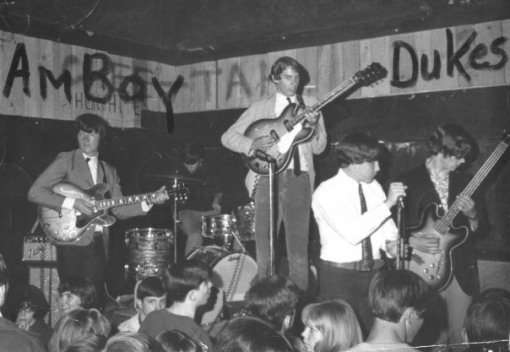
special introductory paragraph
The Amboy Dukes
Journey to the Center of the Mind
Migration
Marriage on the Rocks/Rock Bottom
Survival of the Fittest Live
Call of the Wild
Tooth, Fang & Claw
Before he made his career swinging around on ropes, wearing nothing but a loin cloth like he’s Tarzan, firing flaming arrows at his guitar, adopting a hot, 17-year-old Guatemalan babe so he can sleep with her while continuing to sleep with other girls of non-voting age and still promoting a clean living, drug-free lifestyle, Theodore Anthony “Deadly Tedly” Nugent tore it up for more than a decade with the Amboy Dukes, a criminally underrated band that demonstrated just how wide-ranging the Nuge’s abilities were before he became a solo artist.
Don’t get me wrong; I love me some Ted Nugent. That first album with “Stranglehold” is killer, but I think his earlier work is somewhat overshadowed by his rather boisterous “Motor City Madman” personality. And this is coming from someone who fundamentally agrees with many of his political views. Just that when your persona is one of a loudmouth yahoo, who sings songs like “Wang Dang, Sweet Poontang”, you tend to undercut some of the diversity and nuance in your work.
DIVERSITY AND NUANCE?! YOU ARE TALKING ABOUT TED NUGENT, RIGHT?! Exactly.
Read on, young grasshopper. Ted Nugent released four official LPs with the Amboy Dukes, two as Ted Nugent and the Amboy Dukes – one live and one studio – and then one more as Ted Nugent’s Amboy Dukes before dropping the Amboy Dukes altogether and going full on Ted Nugent. Most of the Amboy Dukes albums have some great material on them; and when they don’t, they’re at least interesting, as I shall soon tell ya…
The Amboy Dukes – Mainstream – 1967
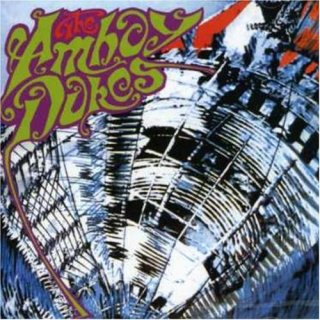
If you’ve bought the propaganda about how great the Deeeetroit rock ‘n’ roll scene was during the mid/late 60s, that it was some sort of loud, fist-pumping alternative to the trends of hippiedom that had taken over the nation in 1967 (and subsequently would be beaten back by the Altamont fiasco at the end of 1969), then those propagandists are only telling you part of the story if they don’t at least give a passing mention to Ted Nugent’s early band, the Amboy Dukes.
In fact, for those acolytes of the Stooges, MC5, Alice Cooper and hell even Grand Funk Railroad, to not KNOW of this here Amboy Dukes band shows a dearth in one’s knowledge of loud, over-driven rock ‘n’ roll that was pumped through stacks of amplifiers in front of kids who looked like hippies, but I guess weren’t actually hippies.
The opening cut on the Dukes’ first LP is a proto-metal cover of the Big Joe Williams blues standard “Baby, Please Don’t Go” (also done by Gary Glitter, Budgie and AC/DC), kicking the album off on a speedy (well, speedy for the 60s) and distortion filled note, challenging the loud guitar supremacy of your Hendrix, Clapton or Page. The Nuge pays a few bars of homage to Hendrix’s “3rd Stone from the Sun” just fo fun as well.
After that the group does a faithful cover of “I Feel Free” by Cream —
I know what you’re thinking, and no, The Amboy Dukes isn’t just a covers album. Of the remaining nine tracks, only two others are covers; “Let’s Go Get Stoned” by the Coasters and “It’s Not True” by the Who. And they DO a great job on both, but come on; they’re covers, ya know? You don’t care how well they do OTHER people’s material; you want to know about their ORIGINAL songs.
The other seven tracks include the catchy blues rock number “Young Love”, the Sitar filled hippie-dippie-trippy psychedelic “Psalms of Aftermath”, the total acid blues freak-out “Colors” – complete with an awesome, quivering two note “hook” during which singer John Drake taunts you with the word “colors” – the wicked “shoulda been a Nugget” garage tune “Down the Philips Escalator”, a cute British sounding piece of psychedelic pop called “The Lovely Lady”, a groovy butt-shakin’ garage number called “Night Time” and a SCORCHIN’ hard rock closing cut called “Gimme Love.”
Bonus points to the CD version for including an awesome surfy number called “J.B. Special” – complete with hand claps! – and the uptempo garage rave up “Sobbin’ in My Mug of Beer”, which sounds JUST LIKE a track that would appear on a Back from the Grave compilation.
As a final note, Ted Nugent LOVES to solo, playing wicked bluesy leads ALL OVER nearly every track; pianist Rick Lober fills out the sound with his background plinking and plunking; John Drake has a melodic and powerful bluesy voice, which he can alter to fit the covers of “I Feel Free” and “It’s Not True” or use to mimic the fruity, British singing style on “The Lovely Lady”; and why not give a hand to the other three members – rhythm guitarist Steve Farmer, bassist Bill White and drummer Dave Palmer – good job keeping the rhythm, guys!
Journey to the Center of the Mind – Mainstream – 1968
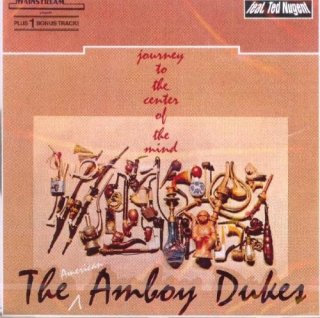
In Steven Miller’s book, Detroit Rock City, several musicians lament the fact that the biggest success stories to come out of the late 60s/early 70s Detroit rock ‘n’ roll scene were Ted Nugent, Bob Seger and Grand Funk Railroad; not the Stooges or the MC5. In other words, the bands who burned out really quickly from their degenerate lifestyles were the “cool” ones, while the bands and musicians who lived somewhat healthier, straight laced lives are considered lame and boring. WHAT A CROCK!!!
First of all, what’s with the musical partisanship? I love the Stooges, MC5, Alice Cooper, Grand Funk Railroad, Ted Nugent AND Bob Seger. Why do I have to pick sides here?
But even more importantly, how are Ted Nugent and his Amboy Dukes NOT considered part of this canon of loud, overdrive rock ‘n’ roll when they delivered upon the Earth “Journey to the Center of the Mind”, a rip-roaring proto-metal number that mistakenly gets lumped in with garage rock “nuggets” like “Psychotic Reaction”, “96 Tears” and “I Had too Much to Dream Last Night”? The track is a scorcher, propelled by the aggressive Keith Moon-like drumming of Dave Palmer, the galloping metal riffs of rhythm guitarist Steve Farmer and Ted Nugent’s leads, which accentuate the riffs, before ripping into a guitar solo and the fuzzed out climax. Okay, John Drake’s acid dropping lyrics are cheesy and outdated, but it’s not as if “Iron Man” or “War Pigs” are known for their lyrical genius either.
There have also been some member changes for the second album! New bassist Greg Arama, who, according to Wiki, was in some band called the Gang, is pretty inconsequential as far as the album’s sound goes. But new keyboardist Andy Solomon definitely takes a more prominent role than his predecessor, Rick Lober; especially in the guitar/keyboard interplay in the AWESEOME “Surrender to Your Kings”, which I will describe in further detail two paragraphs from this one.
Unfortunately Journey to the Center of the Mind is not all high energy, acid fuzz, proto-metal hijinks… not by a long shot. The album kicks off with a Nugent and Farmer penned slow blues jam called “Mississippi Murderer”, which though good, sounds NOTHING like the rest of the album. The rest of the 13 track LP appears to be some sort of song cycle or concept story album, in which Ted Nugent wrote the heavy numbers, while Steve Farmer wrote what sound like typical late 60s, not at all heavy, psychedelic songs, one of which is called “Ivory Castles” and another is “Why Is a Carrot More Orange than an Orange”, and concludes with a track called “Conclusion”, which is just a reprise of “Journey to the Center of the Mind”; ironically it seem as though Farmer was the one who took a journey to the center of his mind.
All of Nugent’s heavy numbers are crammed into the album’s first half; among those include “Surrender to Your Kings” – whose spy/surf verses, distorted chords, keyboard interplay and quick, aggressive tempo make it sound like Iron Butterfly on speed – the groovy “Flight of the Byrd”, which sounds like a heavier version of “Hush” by Deep Purple, and a passable rocker called “Dr. Slingshot.” There’s also a progressive instrumental called “Scottish Tea”, which has some neat marching drums and Renaissance-era sounding melodies, and of course the album’s wicked title track.
The psychedelic numbers in the second half are actually pretty good, if a bit silly. If you know what 60s poppy psychedelia sounds like, I don’t need to describe them to you in too much detail; some sound darker and scarier, like you’re entering some sorta Alice in Wonderland type nightmare, some are more sing-songy, like some sorta “Lucy in the Sky with Diamonds”-coo-coo-ca-choo fruitiness and all at least have the Nuge doing his best Syd Barret/early-Floyd impression. But in spite my earlier remark about how Farmer sounds like he’s on acid, something makes me think that he’s not exactly taking his acid trips too seriously. For instance, check out the lyrics to “Death Is Life”:
Things are getting much worse
People will actually curse
Ladies are sighing and babies are dying
And happiness comes with a hearse
Whats the use? There’s no excuse
Death is life
Seems that you never will learn
The only thing is to return
Do what you care and hope your not there
When all your world start to burn
In fact “Missionary Mary” has an intro that I’m almost positive is intended as a joke; it starts off with a really quick buildup, making you think that the song is going to get fast, and then it obnoxiously just slows down. Also “I’ll Prove I’m Right” is quite a fun toe-tapping number. Unfortunately “Saint Philips Friend” is pretty dull and useless. OH WELL, they can’t ALL be winners, right?
The CD version adds on the bonus track, “You Talk Sunshine, I Breathe Fire”, another fuzzed to hell and super catchy proto-metal rocker, which is also the b-side to the original “Journey to the Center of the Mind” single. Check out that title; methinks Nugent even THEN had his “America, FUCK YEAH” viewpoint firmly intact, in spite the shaggy mane and Indian-hippie swag.
Migration – Mainstream – 1969
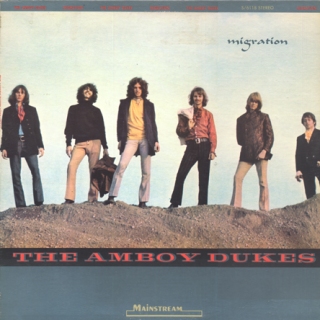
Original singer John (J.B.) Drake migrates out of the Amboy Dukes, and future Cactus singer Rusty Day takes his place. How can you have the Amboy Dukes without John (J.B.) Drake?! Okay, all facetiousness aside, I do think that Drake had a better, bluesier type of baritone singing voice, whereas Day kinda just sounds like a generic 70s rock singer. But what difference does it make? He wouldn’t even make it past Migration anyway. And neither would Steve Farmer; so if you’re one of those “Farmer or bust” types of Amboy Dukes fans, sorry bud, your “journey” ends here!
Featuring nine songs, Migration sounds like the work of a band who thought they wanted to cross over from psychedelia into heavy progressive rock, but didn’t write enough new material, and ended up using leftovers from the previous album session instead.
The first song, “Migration”, is a six minute instrumental jam that has cool space noises; and the second track, “Prodigal Man”, is a multi-part, heavy prog epic that goes on for nearly nine minutes and has a really neat, fuzzed out minor chord riff, a bunch of different parts, time changes and organ and drum solos that make it seem as though the Dukes had just heard “21st Century Schizoid Man” and thought “BINGO!” In fact I’ll go on to say that “Prodigal Man” is the crowning jewel of the album and a career high; the Dukes apparently agree with me, since they would go on and play live versions of the song that would be more than twice as long as the original recording.
Then, all of a sudden, the album turns into a mid-60s, psychedelic, garage rock album, except for a pointless cover of the 1956, doo wop hit “I’m Not a Juvenile Delinquent” and a butt-shakin’, funky-soul song called “Curb Your Elephant”, which has a trombone that makes elephant noises. It’s keyboardist Andy Solomon’s sole songwriting credit; you go, Andy!
Now, I know this review is taking on a pretty negative tone, but hear me out. I LIKE several songs on the album. In fact, the third song, “For His Namesake”, and the final track, “Loaded for Bear”, are totally awesome, upper-tempo, 1966-era, garage rock; the former is pure 60s keyboard rock, and the lyrics are all melodramatic, about this kid who’s parents are tellin’ him, “little Johnny, you gotta grow up and be a man or you’ll bring shame on the family”, and the latter has this killer surfy riff and these bluesy licks.
But some of these other songs make me think, “what the hell were they thinking?” “I’m Not a Juvenile Delinquent” just seems like they used the vocal track from the original Frankie Lymon and the Teenagers version and replaced it with their own instrumental backing. I mean, who IS doing that falsetto? It can’t be Rusty Day or Ted Nugent, can it? And the soft number, “Shades of Green and Grey”, might be taking the piss out of all the “peace and love” nonsense, but it’s just so damn boring!
The other two songs, “Good Natured Emma” (was the Nuge listening to too much Zappa or something?) and “Inside the Outside”, are oookay… the latter has a fun, carnival vibe that might remind you of the Creation or something.
Marriage on the Rocks/Rock Bottom – Polydor – 1970
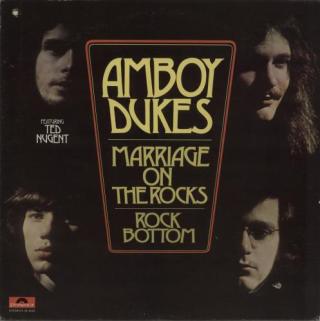
Trimming the fat – who needs six members? – singer Rusty Day and rhythm guitarist Steve Farmer have been given the boot, or they quit; who knows, ya know? I bet you THEY don’t even remember what happened since they were all taking “journeys to the center of their minds” at the time. As mentioned in the previous album review, Day would go on to ultra-mega super stardom with Cactus (what, YOU’VE NEVER HEARD OF CACTUS?! Bastard! Go back and listen to One Way… or Another and Restrictions.), I believe Steve Farmer still probably hangs out somewhere in the suburbs of Detroit and Andy Solomon took over as lead vocalist, except on the track “Non-Conformist Wilderbeast Man.”
The remaining Dukes – guitarist Ted Nugent, keyboardist/saxophonist Andy Solomon, bassist Greg Arama and drummer Dave Palmer – return with an album that has a really awkward title. Wait a minute… is this the right album? Who replaced my copy of Marriage on the Rocks/Rock Bottom with a Frank Zappa record?!
You’re trying to tell me that that’s TED NUGENT playing those complicated jazzy licks, and that the Amboy Dukes are doing all of those really tricky time signature changes and playing those funky beats? And whadaya know; the second song is called “Breast-Fed Gator”, and the final track is “The Inexhaustible Quest for the Cosmic Cabbage.” Nugent and his Dukes must have REALLY gotten into Zappa and his Mothers in 1970, because if you didn’t know who you were listening to, you might actually confuse Marriage on the Rocks/Rock Bottom for a Zappa record like Hot Rats, Weasels Ripped My Flesh, Apostrophe (‘) or Overnight Sensation.
That’s not bad, mind you. It’s just surprising how much of a left turn the band took between Migration and Marriage on the Rocks/Rock Bottom. The fact that Ted Nugent, someone who people think of as Mr. Wango-Tango, can pull off complicated jazzy solos and well crafted fusion/funk/progressive hybrids with technically challenging parts and actually make it work, is somewhat surprising to me. Hey, don’t yell at me! MOST people who know Ted Nugent know him as the wild, hard rock guitar guy, not the precision jazz fusion, nerdy guitar guy.
Marriage on the Rocks/Rock Bottom has eight cuts on it; it opens with a multi-part, nine minute instrumental called “Marriage” that immediately clues you into the whole Zappa fusion thing with how the song starts for a few bars and is interrupted by a piano interlude before starting again. But what a great jam, so pretty and serene at the beginning with the multi-tracked electric and acoustic guitars and keyboard all playing off each other before going into a faster jammy part. Then this Spanish bullfighting music comes in for a few bars, and the song builds up and gets all intense before calming down and getting pretty again.
The rest of the album, with the exception of the high speed, 90 second boogie rock tune,”Non-Conformist Wilderbeast Man”, consists of groove-funk-soul-fusion-prog songs. “Get Your Guns” has a WHOLE bunch of changes, included a flamenco guitar breakdown, a speedy fusion note run and an outro using Spanish scales. “Today’s Lesson (Ladies & Gentleman)” is a James Gang style, funk rocker that’s abruptly interrupted with Eastern melodies, complicated instrumental interplay and a bunch of random guitar sounds and someone with a helium voice saying a bunch of incomprehensible stuff. “Breast-Fed Gator” and “The Inexhaustible Quest for the Cosmic Cabbage” are TOTAL Zappa rip-offs, right down to the deliberately goofy, pinch-nosed vocals. The latter is one of those funny and annoying multi-genre pieces – like “Brown Shoes Don’t Make It” or the entire Mr. Bungle discography – that abruptly switches tone and musical genre every few seconds for no apparent reason and must have been a real pain in the ass for the studio engineer.
Yep, this ain’t no “Cat Scratch Fever.”
Survival of the Fittest Live – Polydor – 1971

The second song on the fifth Amboy Dukes LP is called “Rattle My Snake.” Now THAT’S the Nuge I’ve come to know and love! By the time the Dukes had released Survival of the Fittest Live, Ted Nugent had become the only original member of the group; and given how the band now call themselves Ted Nugent and the Amboy Dukes and how Nugent is pictured by his lonesome dressed like on Injun on the cover, it’s clear that the Dukes have become Ted Nugent’s artistic vehicle. YOU USED THE WORDS “ARTISTIC” AND “TED NUGENT’ IN THE SAME SENTENCE? Eh, suck my dick.
Also, there have been some member changes. Original drummer Dave Palmer was replaced by some guy named K.J. Night, and bassist Greg Arama, who had been in the band since Journey to the Center of the Mind, was pushed aside by a Rob Ruzga; according to Wikipedia, Night and Ruzga had been in a band called The Day & Night Dealers Blues Band (just rolls off the tongue, doesn’t it?). Andy Solomon remains intact as Ted Nugent’s right hand man on keyboards, most of the singing, and a brief saxophone solo.
Recorded entirely live across two nights during the Summer of 1971 at the Michigan Theater in Detroit, Survival of the Fittest Live contains five entirely new songs and a 21 minute version of “Prodigal Man” that occupies all of side two and sounds far more at home on this here album, than on Migration. Now, I know it’s boring and lazy to describe a band by comparing them with two or three other bands, but I’m boring and lazy, so I’m going to describe the music on Survival of the Fittest Live as a cross between James Gang, Bloodrock and/or a 70s heavy rock band that switches between happy, fun and funky songs and long and scary songs with minor notes played on the Hammond organ.
THIS ALBUM ROCKS, and had it been recorded in the studio, included two or three more original songs and given a “fuller” sound, rather than being recorded live, it might have been considered a “second tier” 70s rock classic alongside Bloodrock 2, the Cactus album One Way… or Another or something by Grand Funk Railroad or Budgie. Also it’s disappointing that they made it in 1971, rather in 1969. This is the kind of music the Amboy Dukes SHOULD have been doing two years earlier, rather than the hodgepodge of 60s keyboard rock and funk on Migration or the kooky Frank Zappa music on Marriage on the Rocks/Rock Bottom, because Ted Nugent is a phenomenal “workman” guitarist, slinging wicked blooze licks and funky hard rock riffs like he’s early Joe Walsh or sumthin.
On a specific tip, the Dukes kick off the set with a few bars of “Journey to the Center of the Mind”, then stop it short with a sustained note as if to say, “hey fuckers! THAT was 1968, and THIS is 1971! It’s THREE YEARS LATER, AND WE’RE NOT STUCK IN THE PAST!!!”, before playing the actual first song, an instrumental called “Survival of the Fittest.” The fourth song, “Papa’s Will”, is the group’s doom metal epic, even if the main riff and some of Nuge’s solos are a little too happy to be truly “doomy.” And, in true arena rock spirit, the aforementioned extended version of “Prodigal Man” allows each member to show off on his respective instrument, during which other members introduce each member one by one to the audience; huh huh, I said “member” three times in the last sentence. Also, Andy Solomon throws in some Middle Eastern melodies for good measure and does that tension-building, organ solo thang before Jon Lord would popularize it with Deep Purple. Then the song, and subsequently, the album concludes with an extended jam, another sustained note and a crescendo.
And so ends the journey of Ted Nugent, Andy Solomon and the two other guys. In the three years between Survival of the Fittest Live and Call of the Wild, Nugent would replace his entire band, yet continue to call it Ted Nugent and the Amboy Dukes because, hey, why not? Thank you, good night!
Call of the Wild – DiscReet – 1974
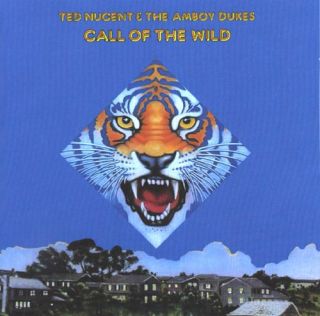
FIRST he wants to SOUND like Frank Zappa, then he gets SIGNED by Frank Zappa! People might find it strange that Zappa would be involved with a straight forward hard rock musician like Ted Nugent, but Zappa has openly praised Grand Funk in the past, and he even produced their 1976 LP, Good Singin’, Good Playin’.
So it REALLY shouldn’t come as a big surprise that he would sign up and distribute records by the Nuge, SHOULD IT?!
What IS surprising is that Ted Nugent continued to call his band Ted Nugent and the Amboy Dukes after he recruited an entirely new band! That’s right; this NEW Amboy Dukes features the singing of Andy Jezowski, the keyboard and flute playing of Gabriel Magno, the bass plucking of Rob Grange and the drumming of Vic Mastrianni. So why did he keep the name? Did Nugent think, “we GOTTA keep the name! No bar around the country will EVER book my NEW band! Who’s this Ted Nugent guy? It’s my backup band, the Amboy Dukes, that they want, and they’re gonna DEMAND that we play ‘Journey to the Center of the Mind’, or they’re going to revoke our goddamn drink tickets, even though I apparently don’t drink!”?
Call of the Wild is the first of two transitional albums that exist in a no man’s land between the Nuge’s earlier career with the old Amboy Dukes and his breakthrough success as the loincloth wearing Detroit wild man, that would begin as early as 1975 with the release of his self-titled debut solo LP.
First of all, what’s with the two instrumentals, “Rot Gut” and “Below the Belt”? I suppose if Ted Nugent wanted to add slow, boring blues jam with piano and slow, boring, spacey, Pink Floyd music to his resume, he now can. But what was the point of including these two tracks? Did the Dukes just not have enough material to make a full length album? The sad thing is that both of these sound like the names of Ted Nugent songs! You’re expecting the Nuge to do hard rockin’ numbers about having rot gut or getting hit below the belt, and you get nothing…
But hey! That leaves six other songs, and they’re all good to really great. I just realized the funky hard rock jam “Renegade” is ALSO an instrumental. That only leaves five songs with singing. Album opener “Call of the Wild” is a major chord, boogie rock song with bluesy backing piano that’s reminiscent of Bob Seger. “Sweet Revenge” is a super catchy and melodic rock tune with acoustic guitar. “Pony Express” and album closer “Cannon Balls” are crushing 70s metal tunes with “chunka-chunka” riffs that are closer to …In Rock era Deep Purple, than hard rockin’ Nugent; the latter even has a neat keyboard solo. And “Ain’t It the Truth” is a melodic hard rock song with multiple parts. Most of the songs are well crafted, feature killer guitar work and are strong additions to the Nugent discography even if they’re stylistically all over the place.
Tooth, Fang & Claw – DiscReet – 1974
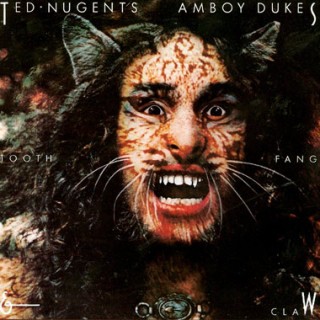
And that brings us to the end of our journey. Technically, on Tooth, Fang & Claw, the band is called Ted Nugent’s Amboy Dukes, and the group has been reduced to 3/5 of the band that played on the previous album. Singer Andy Jezowski and keyboardist Gabriel Magno have taken a hike, turning Nuge’s Dukes into a trio. And even though he’s using the Amboy Dukes name and still signed to Zappa’s Discreet label, you can safely say that Tooth, Fang & Claw is a prototype of Nugent’s solo career.
On Tooth, Fang & Claw, Ted Nugent is once again joined by bassist Rob Grange and drummer Vic Mastrianni, but this time he sings lead vocals on every song; well not EVERY song since “Hibernation” and “Free Flight” are instrumentals, but you get the idea. AND FINALLY, Nugent has found his sound; tough, mean and occasionally funky hard rock – not heavy metal – with multiple parts, melodic solos and an optimistic, “don’t let the man get you down” and “grab life by the balls” philosophy. In fact opening track “Lady Luck”, closing track “No Holds Barred” and somewhere in the middle track “Great White Buffalo” could easily fit on Nugent solo records like Ted Nugent, Free for All or Cat Scratch Fever. Tooth, Fang & Claw has eight songs on it; seven originals and a super speedy (punk rock?!) cover of the Chuck Berry classic “Mabelline.” The aforementioned instrumental “Hibernation” has double-tracked electric and acoustic guitars, and the song “Sasha” is a very pretty acoustic ballad, which I think was written about his daughter. Nugent also expresses his long known love for the great outdoors in “Living in the Woods” and of course “Great White Buffalo”, which has one of the BEST RIFFS EVER that, unlike many a hard rock riff, utilizes individual notes, rather than just power chords. Overall Tooth, Fang & Claw doesn’t have a single dud track and should be considered an early career classic.
And for all of the negative press Ted Nugent gets, I believe several things about the man. One, I believe that he views rock ‘n’ roll not as a vehicle for which to engage in completely wasteful and degenerate behavior, but as an uplifting, positive and inspirational form of music to put on when dealing with what life throws at you. Two, I believe his love and respect for nature and American Indian culture is completely sincere, and that along with it comes his love for hunting, which is not just the sadistic “animal slaughter” his hypocritical enemies portray it as. And three, I believe he is a legitimately talented guitarist with a strong knack for melody and a unique style that, as evidenced by the criminally underrated classic “Great White Buffalo”, differs from many of the guitar heroes of the day. I’ll leave it up to a more experienced guitar expert to decide how he rates compared to, I dunno, Michael Schenker or Eddie Van Halen. I just enjoy his playing.
After Tooth, Fang & Claw, Ted Nugent signed with Epic records, taking bassist Rob Grange with him, recruited Derek St. Holmes on rhythm guitar and lead vocals – something I’ve never understood since Ted Nugent has a perfectly good singing voice – and Cliff Davies on drums and released his classic, self-titled debut solo album in 1975; but that’s another story for another time.
